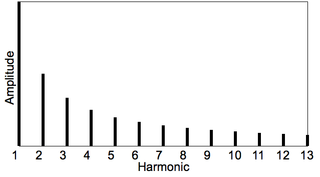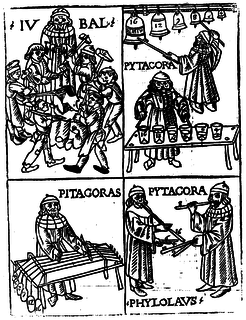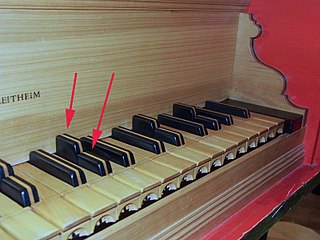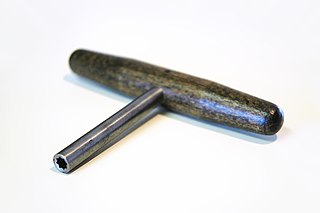 W
WIn music, there are two common meanings for tuning:Tuning practice, the act of tuning an instrument or voice. Tuning systems, the various systems of pitches used to tune an instrument, and their theoretical bases.
 W
WA440 (also known as Stuttgart pitch) is the musical pitch corresponding to an audio frequency of 440 Hz, which serves as a tuning standard for the musical note of A above middle C, or A4 in scientific pitch notation. It is standardized by the International Organization for Standardization as ISO 16. While other frequencies have been (and occasionally still are) used to tune the first A above middle C, A440 is now commonly used as a reference frequency to calibrate acoustic equipment and to tune pianos, violins, and other musical instruments.
 W
WThe archicembalo was a musical instrument described by Nicola Vicentino in 1555. This was a harpsichord built with many extra keys and strings, enabling experimentation in microtonality and just intonation.
 W
WIn music theory, an enharmonic scale is "an [imaginary] gradual progression by quarter tones" or any "[musical] scale proceeding by quarter tones". The enharmonic scale uses dieses (divisions) nonexistent on most keyboards, since modern standard keyboards have only half-tone dieses.
 W
WIn music theory and tuning, an Euler–Fokker genus, named after Leonhard Euler and Adriaan Fokker, is a musical scale in just intonation whose pitches can be expressed as products of some of the members of some multiset of generating prime factors. Powers of two are usually ignored, because of the way the human ear perceives octaves as equivalent.
 W
WFifths tuning is a non-standard tuning for the double bass, used primarily in classical and jazz music. In this tuning, the double bass is tuned like a cello but an octave lower.
 W
WThe fundamental frequency, often referred to simply as the fundamental, is defined as the lowest frequency of a periodic waveform. In music, the fundamental is the musical pitch of a note that is perceived as the lowest partial present. In terms of a superposition of sinusoids, the fundamental frequency is the lowest frequency sinusoidal in the sum of harmonically related frequencies, or the frequency of the difference between adjacent frequencies. In some contexts, the fundamental is usually abbreviated as f0, indicating the lowest frequency counting from zero. In other contexts, it is more common to abbreviate it as f1, the first harmonic.
 W
WIn music, inharmonicity is the degree to which the frequencies of overtones depart from whole multiples of the fundamental frequency.
 W
WMersenne's laws are laws describing the frequency of oscillation of a stretched string or monochord, useful in musical tuning and musical instrument construction.
 W
WMikhail Mishaqa or Michael Mishaka, also known as Doctor Mishaqa, was born in Rashmayyā, Lebanon, and is reputed to be "the first historian of modern Ottoman Syria" as well as the "virtual founder of the twenty-four equal quarter tone scale". Mishaqa's memoir of the 1860 Mount Lebanon civil war is valuable to historians, as it is the only account written by a survivor of the massacre of Syrian Christians in Damascus, Syria. In 1859 he was appointed vice-consul of the United States in Damascus.
 W
WA node is a point along a standing wave where the wave has minimum amplitude. For the instance, in a vibrating guitar string, the ends of the string are nodes. By changing the position of the end node through frets, the guitarist changes the effective length of the vibrating string and thereby the note played. The opposite of a node is an anti-node, a point where the amplitude of the standing wave is at maximum. These occur midway between the nodes.
 W
WOtonality and utonality are terms introduced by Harry Partch to describe chords whose pitch classes are the harmonics or subharmonics of a given fixed tone (identity), respectively. For example: 1/1, 2/1, 3/1,... or 1/1, 1/2, 1/3,....An Otonality is that set of pitches generated by the numerical factors (...identities)...over a numerical constant in the denominator. Conversely, a Utonality is the inversion of an Otonality, a set of pitches with a numerical constant in the numerator over the numerical factors...in the denominator.
 W
WAn overtone is any frequency greater than the fundamental frequency of a sound. Using the model of Fourier analysis, the fundamental and the overtones together are called partials. Harmonics, or more precisely, harmonic partials, are partials whose frequencies are numerical integer multiples of the fundamental. These overlapping terms are variously used when discussing the acoustic behavior of musical instruments. The model of Fourier analysis provides for the inclusion of inharmonic partials, which are partials whose frequencies are not whole-number ratios of the fundamental.
 W
WPiano tuning is the act of adjusting the tension of the strings of an acoustic piano so that the musical intervals between strings are in tune. The meaning of the term 'in tune', in the context of piano tuning, is not simply a particular fixed set of pitches. Fine piano tuning requires an assessment of the vibration interaction among notes, which is different for every piano, thus in practice requiring slightly different pitches from any theoretical standard. Pianos are usually tuned to a modified version of the system called equal temperament.
 W
WAccording to legend, Pythagoras discovered the foundations of musical tuning by listening to the sounds of four blacksmith's hammers, which produced consonance and dissonance when they were struck simultaneously. According to Nicomachus in his 2nd century CE Enchiridion harmonices Pythagoras noticed that hammer A produced consonance with hammer B when they were struck together, and hammer C produced consonance with hammer A, but hammers B and C produced dissonance with each other. Hammer D produced such perfect consonance with hammer A that they seemed to be "singing" the same note. Pythagoras rushed into the blacksmith shop to discover why, and found that the explanation was in the weight ratios. The hammers weighed 12, 9, 8, and 6 pounds respectively. Hammers A and D were in a ratio of 2:1, which is the ratio of the octave. Hammers B and C weighed 9 and 8 pounds. Their ratios with hammer A were and. The space between B and C is a ratio of 9:8, which is equal to the musical whole tone, or whole step interval.
 W
WA quarter tone clarinet is an experimental clarinet designed to play music using quarter tone intervals.
 W
WThe Semantic System is based on a microtonal musical scale tuned in just intonation, developed by Alain Daniélou.
 W
WSlendro is a pentatonic scale, Play (help·info) the older of the two most common scales (laras) used in Indonesian gamelan music, the other being pélog. In Javanese the term is said to derive either from "Sailendra", the name of the ruling family in the eighth and ninth centuries when Borobudur was built, or from its earlier being given by the god Sang Hyang Hendra.
 W
WA split sharp is a kind of key found in some early keyboard instruments, such as the harpsichord, clavichord, or organ. It is a musical key divided in two, with separately depressible front and back sections, each sounding its own pitch. The particular keys that were split were those that play the sharps and flats on the standard musical keyboard.Split sharp. A sharp key divided or 'split' into two parts: the front part is about one third the length of the whole. Usually the back part is set slightly higher to facilitate playing. Each part has its own [parts] so that two notes are available. In Italian instruments it was common...to provide split sharps for e♭/d♯ and g♯/a♭. The usual practice was to put on the front part the note that would normally be found there, e.g. e♭ and g♯.
 W
WSträhle's construction is a geometric method for determining the lengths for a series of vibrating strings with uniform diameters and tensions to sound pitches in a specific rational tempered musical tuning. It was first published in the 1743 Proceedings of the Royal Swedish Academy of Sciences by Swedish master organ maker Daniel Stråhle (1700–1746). The Academy's secretary Jacob Faggot appended a miscalculated set of pitches to the article, and these figures were reproduced by Friedrich Wilhelm Marpurg in Versuch über die musikalische Temperatur in 1776. Several German textbooks published about 1800 reported that the mistake was first identified by Christlieb Benedikt Funk in 1779, but the construction itself appears to have received little notice until the middle of the twentieth century when tuning theorist J. Murray Barbour presented it as a good method for approximating equal temperament and similar exponentials of small roots, and generalized its underlying mathematical principles.
 W
WTonality flux is Harry Partch's term for the kinds of subtle harmonic changes that can occur in a microtonal context from notes moving from one chord to another by tiny increments of voice leading. For instance, within a major third G-B, there can be a minor third G to B, such that in moving from one to the other each line shifts less than a half-step. Within a just intonation scale, this could be represented by
 W
WA tone hole is an opening in the body of a wind instrument which, when alternately closed and opened, changes the pitch of the sound produced. Tone holes may serve specific purposes, such as a trill hole or register hole. A tone hole is, "in wind instruments[,] a hole that may be stopped by the finger, or a key, to change the pitch of the tone produced."
 W
WA tuning wrench is a specialized socket wrench used to tune string instruments, such as the piano, harp, and hammer dulcimer, that have strings wrapped around tuning pins. Other string instruments do not require a tuning wrench because their tuning pins or pegs come with handles, or geared tuning machines.